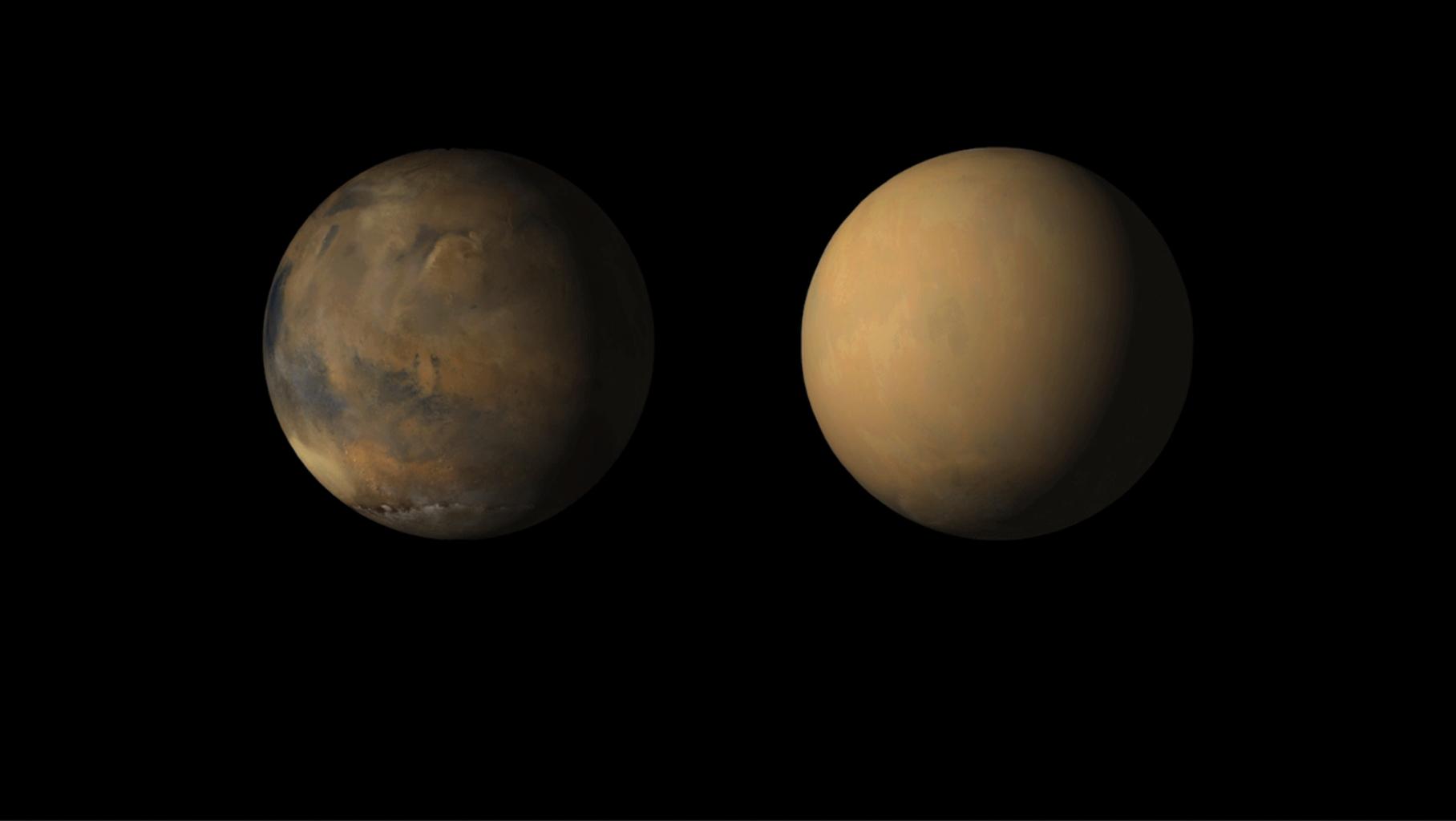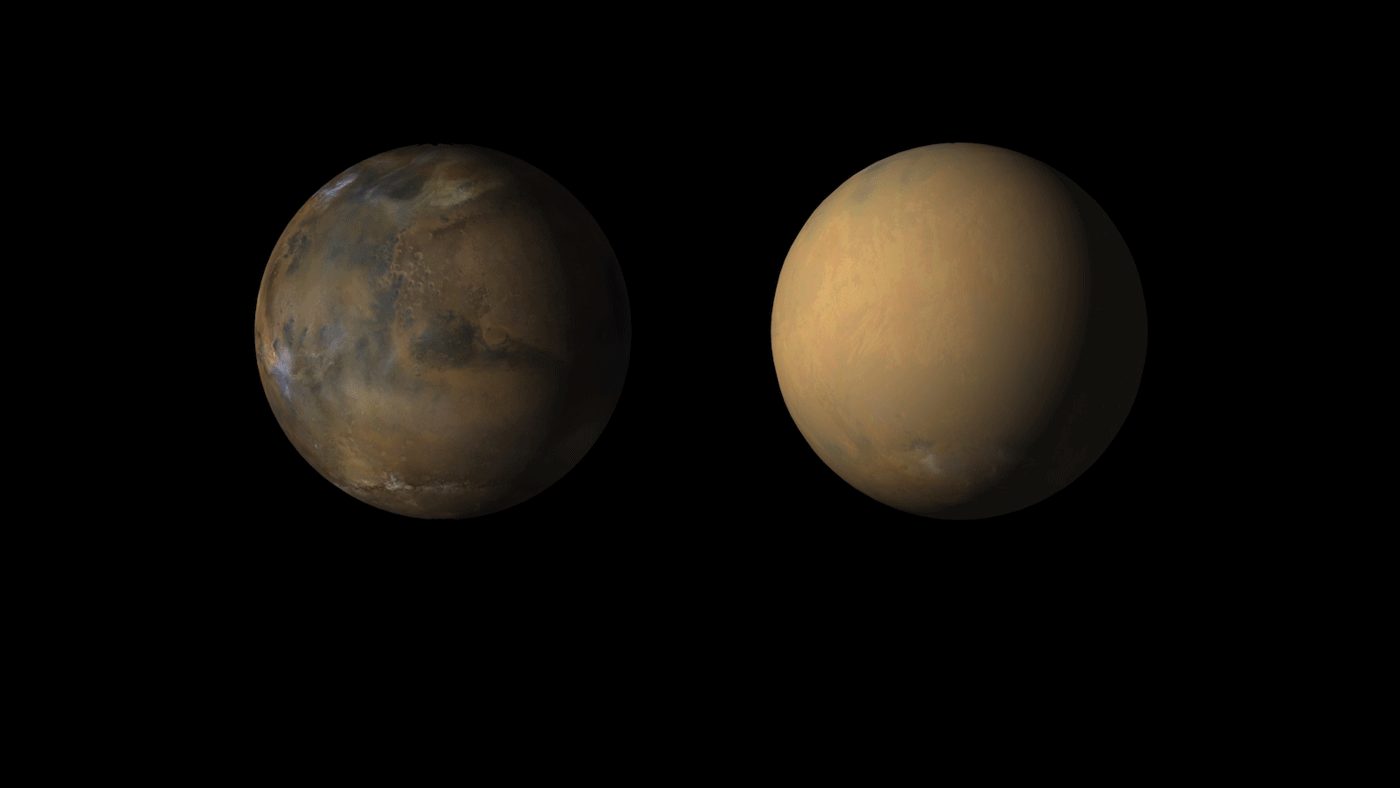
The huge dust storm raging on Mars is a curse for NASA's Opportunity rover but something of a blessing for the space agency's other Red Planet missions.
The solar-powered Opportunity has been silent for weeks, unable to recharge its batteries because of all the light-blocking dust in the air. Mission team members think the six-wheeled rover, which has been exploring Mars since January 2004, has put itself into a sort of hibernation, and they're cautiously optimistic that Opportunity will wake up when the dust clears.
Unfortunately, that may take a while. [Mars Dust Storm 2018: How It Grew & What It Means for the Opportunity Rover]
"Based on the longevity of a 2001 global storm, NASA scientists estimate it may be early September before the haze has cleared enough for Opportunity to power up and call home," NASA officials wrote in a statement Wednesday (July 18).
But other agency missions are taking advantage of a rare opportunity — global dust storms engulf the Red Planet just once every six or eight Earth years — to learn more about the Martian atmosphere and climate.
For example, Opportunity's bigger, younger cousin Curiosity is studying the size and distribution of dust particles in the Red Planet's air using a variety of instruments, including its onboard weather station. (Curiosity is nuclear powered and is therefore largely unbothered by the dust.)
Curiosity's weather data could also shed light on how dust storms affect Martian "atmospheric tides," which are pressure waves that travel widely throughout the planet's air, mission team members said.
Get the Space.com Newsletter
Breaking space news, the latest updates on rocket launches, skywatching events and more!
"We're working double-duty right now," Curiosity project scientist Ashwin Vasavada, of NASA's Jet Propulsion Laboratory (JPL) in Pasadena, California, said in the same statement. "Our newly recommissioned drill is acquiring a fresh rock sample. But we are also using instruments to study how the dust storm evolves."
Then there's the view from above. Three different NASA orbiters are intently eyeing the storm, which began on a localized scale in late May and had gone global by June 20.
Researchers are using the THEMIS (Thermal Emission Imaging System) instrument aboard NASA's Mars Odyssey orbiter to monitor surface and atmospheric temperatures, as well as dust loads in the air.
"This is one of the largest weather events that we've seen on Mars" since up-close spacecraft observations began in the 1960s, THEMIS team member Michael Smith, a scientist at NASA's Goddard Spaceflight Center in Greenbelt, Maryland, said in the same statement. "Having another example of a dust storm really helps us to understand what's going on."
The THEMIS team has increased the pace of the instrument's global-atmosphere measurements from once every 10 days before the dust storm to twice per week now, Smith added.
NASA's workhorse Mars Reconnaissance Orbiter (MRO), which first spotted the storm on May 30, is using two instruments to track its evolution and effect on atmospheric temperatures. This effect can be self-reinforcing, NASA officials said: As dust high in the atmosphere absorbs solar energy and heats up, wind patterns can change, lifting more dust off the planet's surface.

A better understanding of these details, provided by Odyssey and MRO data, could help researchers learn why some Martian dust storms peter out as localized affairs and others go global, NASA officials said.
The agency's Mars Atmosphere and Volatile Evolution orbiter, or MAVEN, is focused on dust-storm effects higher up, where the Red Planet's air meets the vacuum of space. MAVEN's main mission goal involves better understanding how Mars lost its once-thick atmosphere, a pivotal event that caused the planet's climate to shift from relatively warm and wet to cold and dry.
MAVEN's observations have already revealed that Mars' air was stripped by charged particles streaming from the sun, and that the damage began occurring around 4.2 billion years ago, when the Red Planet lost its global magnetic field.
The current situation provides an opportunity to better understand what role, if any, big dust storms play in the atmosphere-stripping process, MAVEN team members said. For example, does the associated heating of the atmosphere cause more air molecules to escape into space?
Ever since MAVEN arrived at Mars in September 2014, "one of the things we've been waiting for is a global dust storm," said MAVEN principal investigator Bruce Jakosky, of the University of Colorado's Laboratory for Atmospheric and Space Physics in Boulder.
Follow Mike Wall on Twitter @michaeldwall and Google+. Follow us @Spacedotcom, Facebook or Google+. Originally published on Space.com.
Join our Space Forums to keep talking space on the latest missions, night sky and more! And if you have a news tip, correction or comment, let us know at: community@space.com.

Michael Wall is a Senior Space Writer with Space.com and joined the team in 2010. He primarily covers exoplanets, spaceflight and military space, but has been known to dabble in the space art beat. His book about the search for alien life, "Out There," was published on Nov. 13, 2018. Before becoming a science writer, Michael worked as a herpetologist and wildlife biologist. He has a Ph.D. in evolutionary biology from the University of Sydney, Australia, a bachelor's degree from the University of Arizona, and a graduate certificate in science writing from the University of California, Santa Cruz. To find out what his latest project is, you can follow Michael on Twitter.









